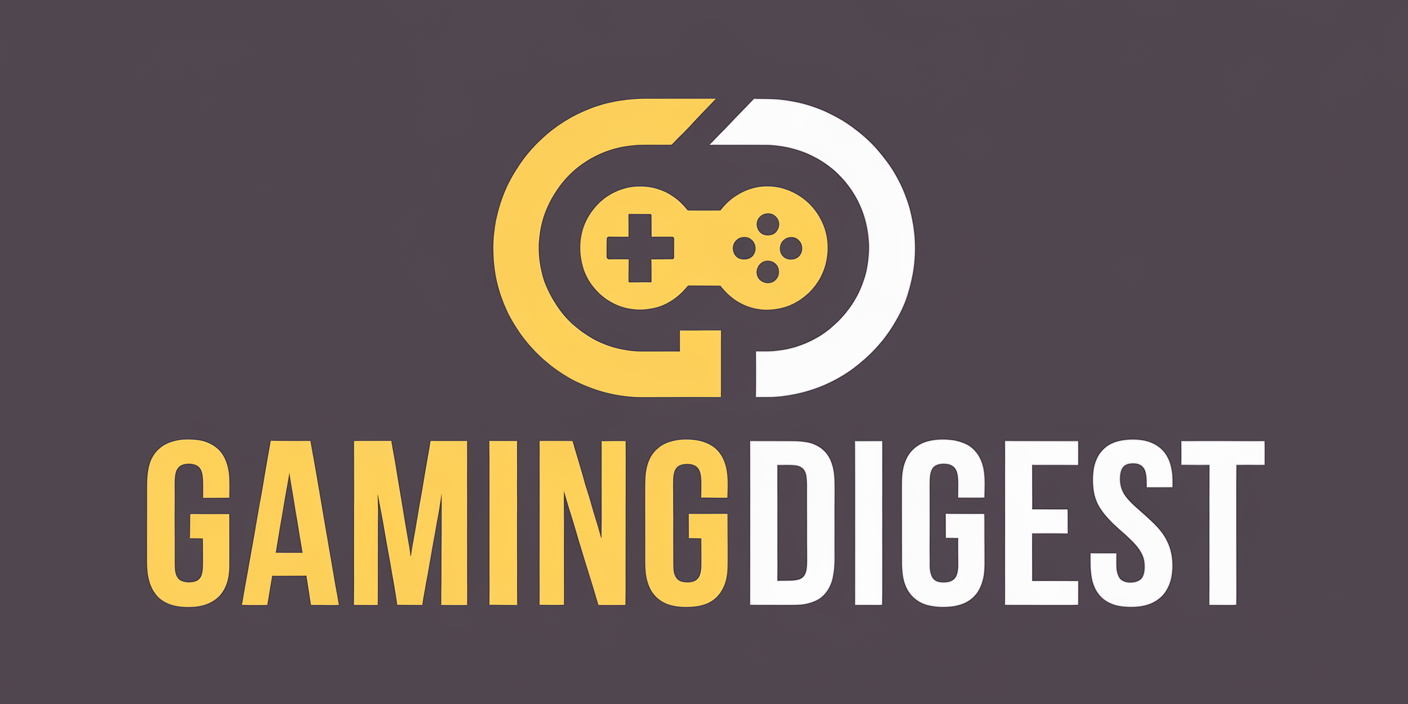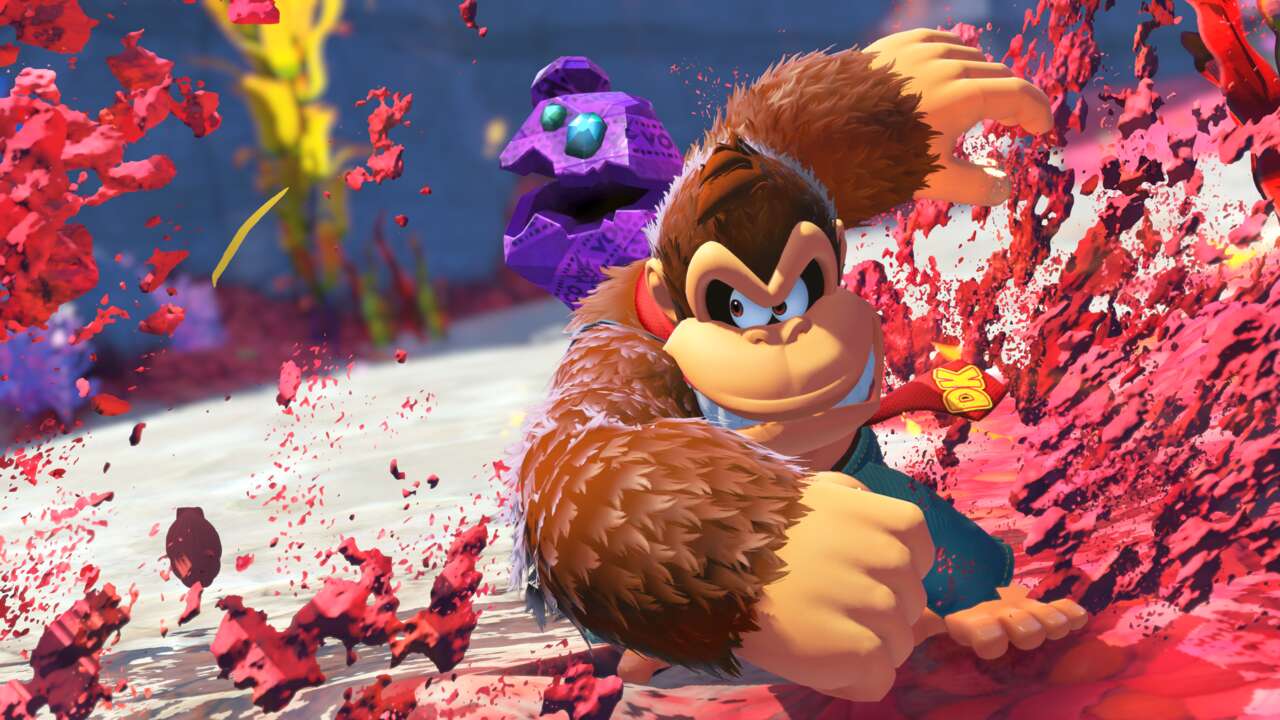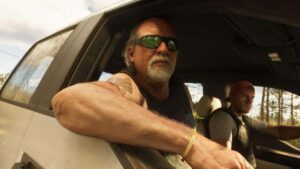I don’t have any keen insight to Nintendo’s process, but if you told me that Donkey Kong Bananza was crafted by a Voltron-like supergroup of key developers from its biggest franchises, I would believe you. At first glance, it bears the strongest resemblance to Super Mario Odyssey, from which it gets most of its fundamental mechanics, structure, and game-feel. Then it augments that with physics-based terrain deformation and experimental flexibility reminiscent of Zelda: Tears of the Kingdom. Finally, it merges both of those into what serves as a soft reboot of Donkey Kong, borrowing bits and pieces from all over the Kong-iverse to make something that is both recognizable and fresh. The result is an excellent platforming adventure that moves with its own propulsive force, constantly beckoning you to dig a little deeper.
The Donkey Kong DNA is important because, for a lot of older gamers, DK as a 3D-platforming star sparks some uneasy feelings. The character has excelled at 2D platformers with the Donkey Kong Country series, but his one 3D outing, Donkey Kong 64, has a mixed reputation. Donkey Kong Bananza, then, is something of a redemption story. This is DK’s star-making role, and may well map the future of the character.
Donkey Kong Bananza recasts DK as a lovable lunk, crazed for bananas and working for some kind of strange banana-mining company. The underground is stocked with crystalized Golden Bananas that provide Bananergy, and a legion of chimps in mining hats chip away at the bedrock to find them. DK doesn’t need a pickaxe, since he can just punch his way through the rocks to find the treasured bananas. But things take a turn when the VoidCo mining company bosses crash through the mine and head toward the planet core. DK chases after them for the promise of recovering his stolen bananas, and along the way meets a strange singing rock that turns out to be a little girl named Pauline, who fans of the very first game may recognize. VoidCo and its boss, Void Kong, have some devious plan for Pauline involving the planet core, so partly to protect her–but mostly for bananas–the two of you team up to uncover their dastardly plot.
It’s classic Saturday-morning-cartoon fair, and that feeling is only accented by the spectacular range of expression in the redesign for DK. Surrounding characters like Void Kong and Pauline look good, along the lines you’ve come to expect from games like Mario Odyssey and the new Mario Kart World. But DK himself is on another level, with an expressive face that squashes and stretches like it stepped out of the animated Mario movie. It infuses the character with enormous personality and heart, which is important to establish a bond between him and Pauline, as she does all the talking.
Like Mario Odyssey, Bananza is built around exploring bespoke environments and gathering up crystalline doodads as your reward for completing open-ended platforming challenges. Unlike Mario Odyssey, those challenges aren’t just about crossing a tricky chasm, but rather, burrowing into the earth itself. You have a few tools at your disposal to find bananas hidden in the bedrock, and finding the right approach to dig your way to them is a big part of the game. You have enormous flexibility to shape and deform the environment and create your own caverns, but this is still Nintendo’s refined stage design at heart. You’ll need to figure out the right approach, rather than simply punching your way through every problem. Though, I should say, punching your way through problems is extremely satisfying, thanks in part to the sound and controller-rumble design.
Another difference from Odyssey is access to new layers of the inner earth, which serve as the game’s stages, is gated behind story progress rather than simply collecting a requisite number of crystal collectibles. You’ll need to destroy a particular VoidCo structure or take on a boss or meet with a massive animal Elder to learn their unique Bananza dance to progress by diving into a hole and falling through to the next layer of crust.
That means the utility of collecting bananas shifts as well, and it’s a change for the better. Collecting five Golden Bananas gives you a skill point, which you can apply to a sizable skill tree to upgrade and customize your Kong. Some upgrades are what you’d expect–more health, more punching power, etc–but others are their own unique skills that open new avenues for exploration. This in turn creates a wonderfully compulsive loop: You’re on the hunt for bananas, to gain more skills, which helps you find even more bananas. If you spot a stray banana in the distance, you feel compelled to go grab it. A sonar clap ability lets you spot collectibles hidden in the rock, and the map is presented in 3D space to pinpoint collectibles. It makes the game feel like there’s something to be found around every corner, and pushes you to keep exploring. It’s enough to make you truly understand DK’s thirst for them. Big boss battles or unlocking a new layer grants a larger banana bunch–three or five–which makes the progress feel rewarding.
All the flexibility of terrain deformation comes at a cost, though. Punching your way through solid rock and making your own pathways can easily throw the game’s camera for a loop, which leads to odd clipping and momentary camera wonkiness. It was never such a struggle that I couldn’t play, but it does expose the artifice a little when you can sporadically see through walls. Worse yet, the level of chaos from terrain being manipulated led to some noticeable performance issues, with framerate drops resulting in noticeable slowdown. This was most pronounced near the end as the deformation got more complex and tumultuous, but it was present throughout. This is particularly unwelcome to see in one of the banner launch window games for Nintendo’s new, substantially stronger hardware.
The main currency of the game are gold shards, which are plentiful and scattered throughout stages in both large troves and little bits and bobs that are awarded for smashing through rock. There’s a satisfying clink-clink to collecting them and large gold caches are often used, like Golden Bananas, to reward small platforming challenges. Your gold reserves are then used to pay for things like shortcuts, items like Balloons (which save you from falling deaths) or treasure maps from the Stuff Shop, or unlocking Base Camps in each area. The more camps you unlock, the more you grow your “Comfy Level,” which gives you a health boost.
You can also augment your powers with a wide array of costumes, which are unlocked with a separate currency: fossils. Each major area has three different types of fossils at different levels of rarity, which are used to unlock costume parts for DK and Pauline. Donkey Kong has different varieties of ties and pants, while Pauline has full outfits to unlock. There are also DK fur shades that are purely cosmetic. The costume parts offer various passive benefits like increased Bananergy or reduced hazard damage, and many of them can be upgraded for more currency to get an even stronger effect. These are fun ways to customize your character, and I wore my fully upgraded, Bananergy-augmenting golden necktie all the way until the end.
However, the sheer variety of fossils is confusing, and I never felt like I had a firm grasp on which fossil unlocked what. They were constantly changing each time I reached a new layer, so I would just visit shops and buy whatever I could afford, rather than consciously save up fossils for particular outfits I wanted. This felt like a remnant of Mario Odyssey’s regional coins, with the rarity levels augmented to gate access to more powerful abilities. But in practice, it’s just too much to keep in your head all at once, and I would’ve preferred a simpler solution.
The most powerful tool at your disposal is the one that gives the game its namesake: your Bananza transformations. A series of massive animal elders, each of them an aspiring DJ, will teach you their Bananza once you collect the missing parts of their turntable record. This activates a jam session with Pauline singing lead vocals–accenting the musical bond between DK and Pauline–and from then on, you can turn into a super-powered beast like a silverback gorilla or a hulking zebra. These are activated via Pauline’s singing, so each unlock features a cute and indulgently goofy performance from Pauline. Then when it comes time to activate the Bananza, Pauline sings a tune while DK keeps the beat by pounding his chest.
These Bananza forms give the game a distinct Zelda-like feel, as they often function like dungeon tools that unlock new pathways and let you explore areas that were previously closed off to you. The Kong Bananza can punch through tougher materials, the Ostrich Bananza can flutter through the air to reach new heights, and the Zebra Bananza is so fleet-footed that it can run across breakable terrain without falling through. That doesn’t even cover my personal favorite Bananza, which is best experienced for itself. And pure mechanics aside, the look of the Bananza forms is just plain funny, reinterpreting common zoo creatures as swole-as-hell bodybuilders complete with banana-themed accessories.
Your Bananza energy is charged by collecting gold, so you can be building up the Bananza meter while already in Bananza form and ready to trigger it again. But somewhat counterintuitively, you don’t simply stay transformed for as long as you collect gold to feed the meter. Instead, it will deplete entirely, and then you need to trigger it anew. This is probably a concession to make sure you can’t simply stay in your superpowered transformations indefinitely, but it takes some getting used to.
The Bananzas, and the world itself, is imbued with a sense of constant surprise. Just when you think you’ve gotten a feel for everything the game has to offer and how it works, it throws another curveball at you. You’re used to punching through rocks and then suddenly there’s an on-rails shooter on a minecart. Individual challenge stages might put you into a retro sidescroller or make you rethink combat in a new way to solve a puzzle. Material types start to interact in new and surprising ways. Like hunting Golden Bananas, it’s all built to keep you moving forward, while looking forward to the next thing, and I was delighted every time I found something new.

Gallery
The game also manages to surprise because it’s not particularly beholden to or precious about its own existing lore. I’ve cheekily addressed the continuity issues, but to answer any lingering questions, Donkey Kong Bananza functions mainly like a reboot. Still, even that’s not quite the cleanest way to describe it. In some ways it seems like a prequel, in other ways characters will openly reference having gone on past adventures from other games, and sometimes it will even seem to reinterpret familiar iconography. The result is a kind of hyper-reality that more than anything reminded me of The Simpsons–a show in which Bart can remain 10 years old for over 35 years now, Homer and Marge were in high school across multiple different decades, and past continuity is brought up only in service of when the story needs it. Does it make sense? Shut up, don’t worry about it. That playful sense of borrowing story elements as needed makes this feel like a fresh start, while at the same time rewarding longtime fans with Easter eggs.
The story it tells, of DK accompanying Pauline to the planet core so she can make a wish, is simple and sweet-natured. The two bond through music, through interstitial dialogue scenes when you take a nap in a base camp, and through the main story. As you might expect, DK comes to feel protective of Pauline, and she brings out the best in him. By the end I felt a real kinship between the two and wanted to see more adventures with them together.
Donkey Kong Bananza offers a new start for Donkey Kong that is distinct from the Donkey Kong Country games. The focus on destructability captures what makes DK different from other platforming characters–his titanic strength–and giving him a cute sidekick grants the game unexpected emotional depth. As part of the launch line-up for the Switch 2, this nicely fills the gap for one of Nintendo’s signature substantial single-player adventures. But more importantly, it’s an excellent game in its own right, and deserves to be mentioned alongside games like Mario Odyssey as among Nintendo’s best recent work.









